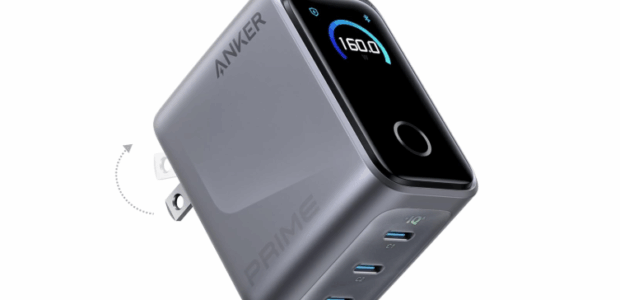
An Anker Prime Charger A2687 160W First Look – Can this charger, bridging vast distances to reach us, reclaim the esteemed reputation of the Anker Prime series?

— Design —
▽ The initial impression of the Anker Prime Charger is that of a “distinctive take on the AirPods Pro.” It inherits the excellent family design language of the Prime series (though aesthetics remain subjective, of course), while adding a smooth, scratch-resistant satin-brushed finish. A fluid contour line around the middle not only enhances the look but also makes it easier to unplug.

▽ The three USB-C ports are surrounded by a laser-etched panel reminiscent of the one found on the A2343 charger. A clearer display is neatly embedded on the front. Its specs—160W Max, dimensions of 65×52×35mm, a volume of 118.3cc, and a power density of 1.353W/cm³—speak to its impressively compact size.

— Performance —
PDO Single Port: 5V⎓3A / 9V⎓3A / 15V⎓3A / 20V⎓5A / 28V⎓5A / 28V⎓5.36A (150W Max)
PDO Multi-Port: 100W+30W+30W (Port Priority Mode), 70W+70W+20W (Dual Laptop Priority Mode), and a user-defined power distribution mode via the Anker app (160W Max).
PDO Special: 5-11V⎓5A PPS (AI 2.0 Mode), 15-28V⎓140W EPR AVS, and a 28V⎓5.36A 150W proprietary mode for the Prime A110A power station activated using cables like the A88E2.
▽ Protocol support prioritizes PD3.1, PPS, and QC, while also including basic support for FCP, SCP, AFC, DCP, and Apple 2.4A. Fortunately, many modern Chinese smartphones support PPS with average charging speeds of around 40-50W.
▽ The first test involved a 10-hour full load stress test at 160W (80W+80W) under conditions of “220V input, 33°C ambient temperature, no external cooling.” The graph plotted from POWER-Z test tool data shows the Anker Prime Charger completing the test stably, with the overall temperature hovering around 72°C. Based on power consumption readings from a smart plug, the charger’s efficiency was calculated to be approximately 93%.
▽ To evaluate the actual output capability, we used an A1340 (27,650mAh / 99.45Wh) and a C300AC (90,000mAh / 288Wh) as receiving devices, with a Zolo A2697 (140W) charger as a comparison. Under similar test conditions (“220V input, 33°C ambient temperature, no external cooling”), the Pages chart data indicates that the A2687 outperformed the A2697 in both output stability and efficiency. As expected, the A2687’s temperature was also significantly lower than during the initial 10-hour stress test. (For the record, the ideal comparison unit, the A2340, was unavailable as it had been gifted away.)
▽ As a core feature of the Prime line, the new Power IQ5 technology, utilizing a built-in MCU for power monitoring and control, has finally debuted. It upgrades the previous passive power distribution cycle (every 3 minutes) to an AI-driven active distribution cycle (every 2 minutes). It locally records and learns the charging curve of each device and can predict the power required for the next cycle based on historical data, dynamically allocating power accordingly. Combined with GaNPrime 2.0 and ActiveShield 4.0, this enables higher efficiency, a seamless user experience, faster charging, intelligent management, and better thermal performance. Naturally, the connected device must also support the necessary protocols for IQ5 to function fully.

— App —
▽ The A2687 can be connected to the ‘Anker app’ via Bluetooth. This allows you to visualize the charging curves and the intelligent power distribution process of Power IQ5 on a larger screen. You can quickly switch between the two preset modes and a DIY custom mode depending on your devices and scenario.
▽ Additionally, the Cable Detection feature conveniently identifies the type of cable being used. Functions like port management and device management are also available. Over-the-air (OTA) firmware updates via the app ensure the A2687 remains up-to-date, preventing it from becoming obsolete.
— Conclusion —

In summary, examining the Anker Prime A2687 160W Charger reveals that its speed is engineered into its foundation, its stability is coded into its algorithms, and its intelligence is manifested at the app level.
It’s not merely a routine power upgrade. A more efficient internal architecture results in a smaller size and lower heat generation, while the smarter Power IQ5 technology delivers a more stable and efficient dynamic power distribution experience.
This represents a conceptual leap from the “wattage race” to “intelligent energy management.” Perhaps the title of “The World’s Smallest and Most Efficient PD3.1 Multi-Port Charger” is earned precisely through such natural, meaningful innovation.
So, allow me to say it once more: Only Anker Prime can do!
